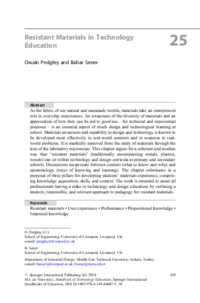Resistant Materials in Technology EducationOwain Pedgley, Bahar Sener
|
 |
 Diese Seite wurde seit 7 Jahren inhaltlich nicht mehr aktualisiert.
Unter Umständen ist sie nicht mehr aktuell.
Diese Seite wurde seit 7 Jahren inhaltlich nicht mehr aktualisiert.
Unter Umständen ist sie nicht mehr aktuell.
 Zusammenfassungen
Zusammenfassungen
 As the fabric of our natural and manmade worlds, materials take an omnipresent role in everyday experiences. An awareness of the diversity of materials and an appreciation of how they can be put to good use - for technical and experiential purposes - is an essential aspect of much design and technological learning at school. Materials awareness and capability in design and technology is known to be developed most effectively in real-world contexts and in response to real-world problems. It is markedly removed from the study of materials through the lens of the laboratory microscope. This chapter argues for a coherent and modern way that 'resistant materials†(traditionally encompassing metals, plastics, woods) can sit within technology and design curricula at primary and secondary schools. Discussions reciprocate between content (what to know and why) and epistemology (ways of knowing and learning). The chapter culminates in a proposal of three pillars for developing students´ materials experience, comprising knowledge acquisition, skills, and context. The work is intended to assist all professionals having a stake in technology and design education, by outlining a modern, responsible, and relevant approach to pedagogy for resistant materials.
As the fabric of our natural and manmade worlds, materials take an omnipresent role in everyday experiences. An awareness of the diversity of materials and an appreciation of how they can be put to good use - for technical and experiential purposes - is an essential aspect of much design and technological learning at school. Materials awareness and capability in design and technology is known to be developed most effectively in real-world contexts and in response to real-world problems. It is markedly removed from the study of materials through the lens of the laboratory microscope. This chapter argues for a coherent and modern way that 'resistant materials†(traditionally encompassing metals, plastics, woods) can sit within technology and design curricula at primary and secondary schools. Discussions reciprocate between content (what to know and why) and epistemology (ways of knowing and learning). The chapter culminates in a proposal of three pillars for developing students´ materials experience, comprising knowledge acquisition, skills, and context. The work is intended to assist all professionals having a stake in technology and design education, by outlining a modern, responsible, and relevant approach to pedagogy for resistant materials. Dieses Kapitel erwähnt ...
Dieses Kapitel erwähnt ...
 Anderswo finden
Anderswo finden
 Volltext dieses Dokuments
Volltext dieses Dokuments
 |  Resistant Materials in Technology Education: Artikel als Volltext bei Springerlink ( Resistant Materials in Technology Education: Artikel als Volltext bei Springerlink ( : :  , 525 kByte; , 525 kByte;  : :  ) ) |
 Anderswo suchen
Anderswo suchen 
 Beat und dieses Kapitel
Beat und dieses Kapitel
Beat hat Dieses Kapitel während seiner Zeit am Institut für Medien und Schule (IMS) ins Biblionetz aufgenommen. Er hat Dieses Kapitel einmalig erfasst und bisher nicht mehr bearbeitet. Beat besitzt kein physisches, aber ein digitales Exemplar. Eine digitale Version ist auf dem Internet verfügbar (s.o.). Aufgrund der wenigen Einträge im Biblionetz scheint er es nicht wirklich gelesen zu haben. Es gibt bisher auch nur wenige Objekte im Biblionetz, die dieses Werk zitieren.











 Biblionetz-History
Biblionetz-History